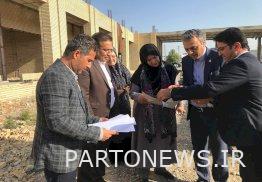The visit of the country’s handicrafts deputy to the implementation process of the Aqqla handicrafts bazaar

According to Aria Heritage report, according to the public relations of the Golestan General Directorate of Cultural Heritage, Tourism and Handicrafts, Maryam Jalali, the deputy of the country’s handicrafts and traditional arts, this afternoon, Tuesday, July 21, 1401, on the sidelines of the visit to the executive operation process of this bazaar, which was attended by Suleiman Hashemi, the governor of Aqqola city, Rahman Farmani, the head of the General Directorate of Cultural Heritage. Tourism and Handicrafts of Golestan, said: “Creating this permanent bazaar for the supply of handicraft products is a very valuable measure to support handicraft artists.”
He noted: “According to the scope and specifications of the project, this center can be a place for the supply of handicrafts produced by artists from other cities.”
On the sidelines of the visit, Suleiman Hashemi, the governor of Aqqola city, also said: “In Aqqola city, there are about two thousand artisans of traditional arts and crafts, which is one of the unique works of the city in the field of handicrafts and traditional Turkmen ornaments.”
During this visit, Rahman Farmani, head of the General Directorate of Cultural Heritage, Tourism and Handicrafts of Golestan, reminded: “From the approvals of the visit of the President of the Islamic Republic of Iran to the province, an amount of 60 billion Rials has been allocated for the permanent handicraft market of Aqqola, with this amount of funds for the first phase of this project. It will be put into operation in 1401.”
Aqqla permanent handicraft market has been designed with an investment of about 150 billion Rials in an area of 3,700 square meters and an infrastructure of about 1,900 square meters on 2 floors.
This project, which is being implemented with about 50% physical progress, includes 57 booths selling handicraft products, a museum and an administrative department, which will provide employment for 72 people after its implementation and operation.
.jpg)

